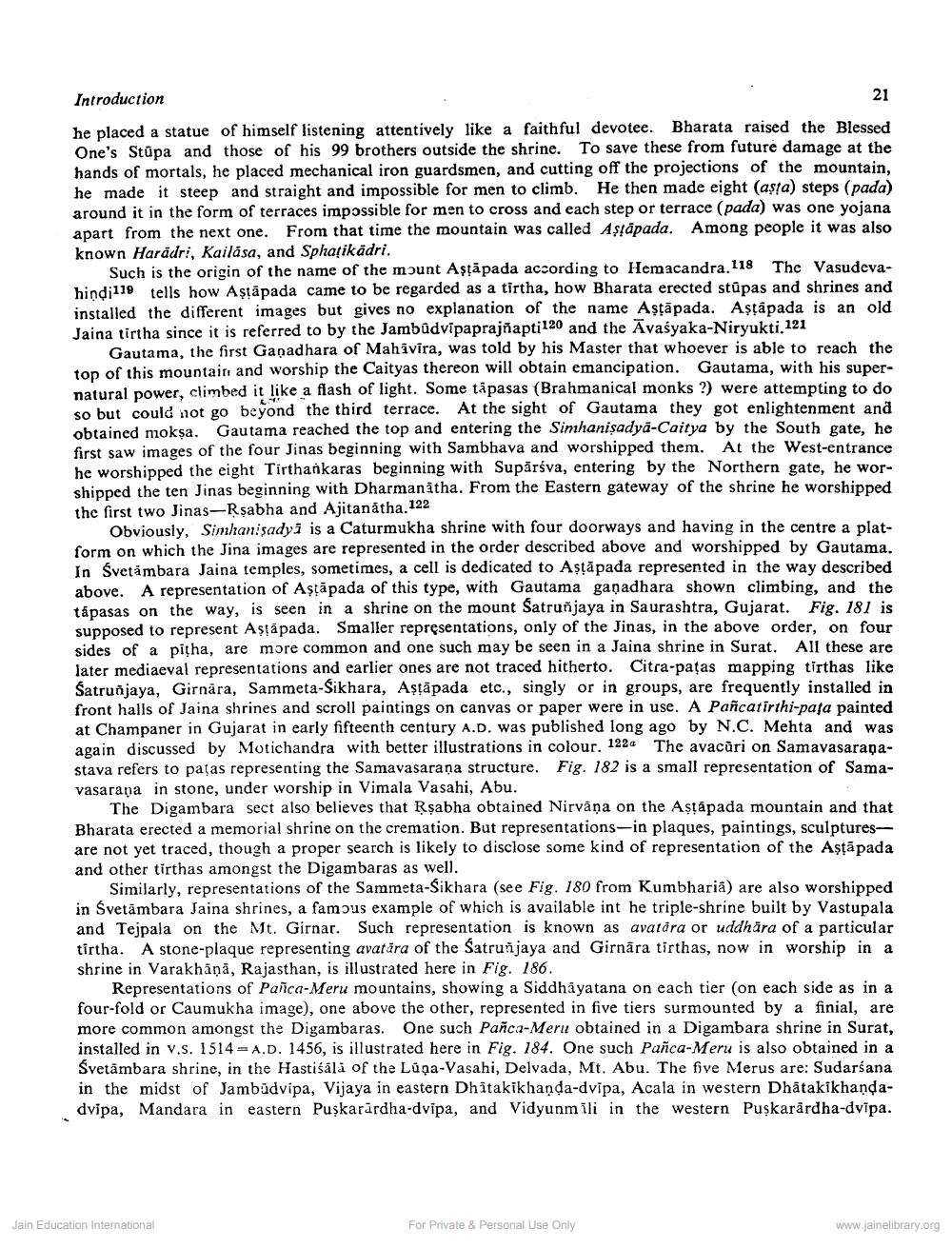________________
21
Introduction he placed a statue of himself listening attentively like a faithful devotee. Bharata raised the Blessed One's Stūpa and those of his 99 brothers outside the shrine. To save these from future damage at the hands of mortals, he placed mechanical iron guardsmen, and cutting off the projections of the mountain, he made it steep and straight and impossible for men to climb. He then made eight (aşta) steps (pada) around it in the form of terraces impossible for men to cross and each step or terrace (pada) was one yojana apart from the next one. From that time the mountain was called Astăpada. Among people it was also known Harādri, Kailasa, and Sphatikādri.
Such is the origin of the name of the mount Astăpada according to Hemacandra.118 The Vasudevahindi119 tells how Astăpada came to be regarded as a tirtha, how Bharata erected stupas and shrines and installed the different images but gives no explanation of the name Aştāpada. Astâpada is an old Jaina tirtha since it is referred to by the Jambūdvīpaprajñapti 120 and the Avaśyaka-Niryukti. 121
Gautama, the first Ganadhara of Mahivira, was told by his Master that whoever is able to reach the top of this mountain and worship the Caityas thereon will obtain emancipation. Gautama, with his supernatural power, climbed it like a flash of light. Some tåpasas (Brahmanical monks ?) were attempting to do so but could not go beyond the third terrace. At the sight of Gautama they got enlightenment and obtained moksa. Gautama reached the top and entering the Simhanisadya-Caitya by the South gate, he first saw images of the four Jinas beginning with Sambhava and worshipped them. At the West-entrance he worshipped the eight Tirthankaras beginning with Supārsva, entering by the Northern gate, he worshipped the ten Jinas beginning with Dharmanatha. From the Eastern gateway of the shrine he worshipped the first two Jinas-Rşabha and Ajitanatha. 122
Obviously, Simhan: sadyi is a Caturmukha shrine with four doorways and having in the centre a platform on which the Jina images are represented in the order described above and worshipped by Gautama. In Svetambara Jaina temples, sometimes, a cell is dedicated to Astăpada represented in the way described above. A representation of Astăpada of this type, with Gautama ganadhara shown climbing, and the tápasas on the way, is seen in a shrine on the mount Satrunjaya in Saurashtra, Gujarat. Fig. 181 is supposed to represent Astapada. Smaller representations, only of the Jinas, in the above order, on four sides of a pitha, are more common and one such may be seen in a Jaina shrine in Surat. All these are later mediaeval representations and earlier ones are not traced hitherto. Citra-pațas mapping tirthas like Šatruñiaya. Girnāra, Sammeta-Sikhara, Aştāpada etc., singly or in groups, are frequently installed in front halls of Jaina shrines and scroll paintings on canvas or paper were in use. A Pañcatirthi-pata painted at Champaner in Gujarat in early fifteenth century A.D. was published long ago by N.C. Mehta and was again discussed by Motichandra with better illustrations in colour. 1220 The avacuri on Samavasaranastava refers to patas representing the Samavasarana structure. Fig. 182 is a small representation of Samavasarana in stone, under worship in Vimala Vasahi, Abu.
The Digambara sect also believes that Rşabha obtained Nirvana on the Aştāpada mountain and that Bharata erected a memorial shrine on the cremation. But representations-in plaques, paintings, sculpturesare not yet traced, though a proper search is likely to disclose some kind of representation of the Aştāpada and other tirthas amongst the Digambaras as well.
Similarly, representations of the Sammeta-Sikhara (see Fig. 180 from Kumbharia) are also worshipped in Svetāmbara Jaina shrines, a famous example of which is available int he triple-shrine built by Vastupala and Tejpala on the Mt. Girnar. Such representation is known as avatara or uddhära of a particular tirtha. A stone-plaque representing avatara of the Satrunjaya and Girnāra tirthas, now in worship in a shrine in Varakhână, Rajasthan, is illustrated here in Fig. 186.
Representations of Panca-Meru mountains, showing a Siddhāyatana on each tier (on each side as in a four-fold or Caumukha image), one above the other, represented in five tiers surmounted by a finial, are more common amongst the Digambaras. One such Panca-Meru obtained in a Digambara shrine in Surat, installed in V.S. 1514 = A.D. 1456, is illustrated here in Fig. 184. One such Panca-Meru is also obtained in a Svetāmbara shrine, in the Hastiśālā of the Lūņa-Vasahi, Delvada, Mt. Abu. The five Merus are: Sudarśana in the midst of Jambudvipa, Vijaya in eastern Dhitakikhanda-dvipa, Acala in western Dhatakikhandadvipa, Mandara in eastern Puşkarārdha-dvipa, and Vidyunm ili in the western Puskarardha-dvipa.
Jain Education International
For Private & Personal Use Only
www.jainelibrary.org




